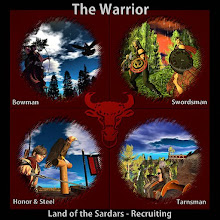
Saturday April 18, 2009, 3 PM SLT
Finding Isadora - A dance tribute to Isadora Duncan by Just Dance
Presented by Isadora Shilling, Choreographer and principle dancer of Just Dance!
MUSIC:
The Music used in this performance are selections that research has shown Isadora used in her actual shows. Please refer to the New York Times article at this URL to read the article: http://www.nytimes.com/2008/08/25/arts/dance/25dunc.html?_r=1
Chopin - Berceuse in Db Op. 57
-----------------------------------
Literally translated as 'cradle song,' Berceuse is a lullaby showcasing Chopin's talent in improvisation and construction of variations. Built over a simple harmony, the melody and variations are delicately formed and based on a theme in 6/8 time.
Beethoven - Symphony No. 7 in A major (Op. 92) – Movement II. Allegretto
---------------------------------------------------------------------------------
The Allegretto from Beethoven's Symphony No. 7 is one of the world's best-loved pieces of music, evoking inspiration and affection since its first performance in 1812. The second movement, in A minor, is "slow", although the tempo marking is Allegretto ("a little lively"), making it slow only in comparison to the other three movements. This movement was encored at the premiere and has remained popular since. The ostinato (repeated rhythmic figure) of a quarter note, two eighth notes and two quarter notes is heard repeatedly
Schubert - Symphony No. 7 in A major (Op. 92) – Movement I. Vivace
---------------------------------------------------------------------------
After a long, expanded introduction in Poco sostenuto, the first movement is in sonata form and is dominated by lively dance-like rhythms.
Tchaikovsky - Symphony No. 6 in B minor, Pathétique, Op. 74 - II Allegro con grazia
-------------------------------------------------------------------------------------------
This was Tchaikovsky's final symphony, first performed under his direction just nine days before his death. The second movement is written in the key of D Major. Written in the unusual time signature of 5/4, it takes the form of a lively dance.
Tchaikovsky - Symphony No. 6 in B minor, Pathétique, Op. 74- III Allegro molto vivace
----------------------------------------------------------------------------------------------
The third movement revolves around two themes, a jittery motif in the woodwinds and a march originating in the brass section. The harmonic structure is based on the tonic and subdominant rather than the more typical tonic and dominant, and culminates in a full orchestral scoring of the majestic brass theme, often causing audiences to conclude the Symphony has finished.
*************************************************************************
Isadora Duncan (May 26, 1877 – September 14, 1927)
--------------------------------------------------------------
Born in San Francisco, California, Isadora Duncan was an artist who broke the molds of convention. From troubled beginnings, she started her dance career in the United States but soon became disillusioned by the rigidity of the classical dance form. By the age of 22 she made the decision to move to Europe where her new ideals were welcomed and earned her noteriety within two years.
Early in her European career, she was dancing to catchy but lightweight music. When she asked a critic how he would propose she improve her performance, he suggested better music - Chopin. Her Chopin dances soon became part of her legend, and she inspired other choreographers of the time to utilise his music as well. She went on to include other major yet often unconventional composers in her work, including Bach, Gluck, Beethoven, and Tchaikovsky.
Always challenging the formality of classical ballet which she saw as "ugly and against nature," she rejected formal steps in favor of improvisation and beauty in the human form. Her costuming was similarly rebellious as she danced barefoot in clinging scarves and grecian tunics.
While her great contributions to the world of dance are still making their mark today, her personal life was sadly punctuated with tragedy and she was often the subject of scandal. She died in a bizarre accident in Nice, France when one of her trademark long flowing scarves was entangled in the wheel of the automobile in which she was a passenger.
Isadora Duncan continues to influence the arts today and is often referred to as the mother of modern dance. By tracing the roots of dance as a sacred art, she reinvented it as a natural and free expression of movement. Through the simplicty of her choreography and focus on the human form as the source of energy and movement, she brought new life to dance as an art form.
Just Dance!
Isadora Shilling, Founder and Choreographer








1 comment:
You may be interested in some real life dancing through the Isadora Duncan Dance Foundation
www.isadoraduncan.org
Judging from your bio on Isadora, you may have already read out bio on her.....
smile,
Lori Belilove
Artistic Director
Isadora DUncan Dance Company and Foundation
Post a Comment